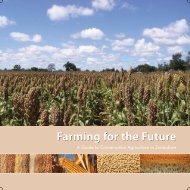Restoring the Soil - Canadian Foodgrains Bank
Restoring the Soil - Canadian Foodgrains Bank
Restoring the Soil - Canadian Foodgrains Bank
Create successful ePaper yourself
Turn your PDF publications into a flip-book with our unique Google optimized e-Paper software.
70Green Manure/Cover Crop Systemsspaced anywhere from 8 m to 12 m square. Parallel rows of nyama would run underevery row or every o<strong>the</strong>r row of trees (i.e. every 12 to 24 m across <strong>the</strong> field). In driernor<strong>the</strong>rn areas, where <strong>the</strong> nyama grows ra<strong>the</strong>r slowly, tephrosia (Tephrosia vogelii or T.candida) could be planted along with <strong>the</strong> nyama to provide plenty of organic matteruntil <strong>the</strong> nyama is large enough to do so.With sufficient rainfall, <strong>the</strong> mo<strong>the</strong>r of cacao trees will produce well within five toseven years, and <strong>the</strong> nyama would produce sometime before that. Within seven years,this system would produce enough gm/cc organic matter to maintain soil fertility. Byincluding <strong>the</strong> already traditional cowpeas, peanuts and Bambara groundnuts (whosenitrogen would be better-maintained because of <strong>the</strong> dispersed shade), I am sure <strong>the</strong>system would be capable of increasing soil fertility in <strong>the</strong> Sahel, without using anychemical fertilizer.42. Benin. Two plots on a research station show<strong>the</strong> relative growth of speargrass with and withoutmucuna. (This is <strong>the</strong> only photo of green manuresused in this book that was not taken on <strong>the</strong> field ofa farmer who had already adopted <strong>the</strong> use of greenmanures.)BeninS59. All crops/mucuna. Mucuna is used inBenin to control imperata grass (Imperatacylindrica, generally called speargrass inWest Africa). Imperata grass is one of<strong>the</strong> world’s most noxious weeds (Photo42). With mucuna, imperata-dominatedwastelands are returned to cultivation.The specific techniques vary somewhat,depending on <strong>the</strong> level of infestation ofimperata grass. Usually <strong>the</strong> imperata grassmust be burned. Mucuna is <strong>the</strong>n planted.The imperata grass may need to be cutonce more to let <strong>the</strong> mucuna developsufficiently to smo<strong>the</strong>r it. The imperata grass will die after being shaded four or fivemonths. Often <strong>the</strong> last 5% of <strong>the</strong> imperata grass must be eliminated by hand. Thelast I knew, 14,000 farmers were using this system, which was largely introduced byIITA (International Institute of Tropical Agriculture) in Nigeria. 25 Sometimes tithonia(Tithonia diversifolia) is used in a similar manner to control imperata grass. Leucaenaand mo<strong>the</strong>r of cacao can also be used, but <strong>the</strong>se take three or four years to shade out<strong>the</strong> weed.CameroonS60. Tephrosia fallow. Tephrosia vogelii is used as an improved fallow near <strong>the</strong> townof Bamenda. A year or two after <strong>the</strong> tephrosia is planted, it is cut down and croppingbegins again. The fertilizing effect of this one-year improved fallow equals <strong>the</strong> impactof between two and four years under a natural fallow (Photo 43). One farmer starteddoing this in <strong>the</strong> late 1990s; eight years later <strong>the</strong> practice had spread spontaneously25Okon, Paul B. and Uche C. Amalu, “Rehabilitation of Degraded Tropical Farms Using Weed to Fight Weed,” n.d.Unpublished.
















